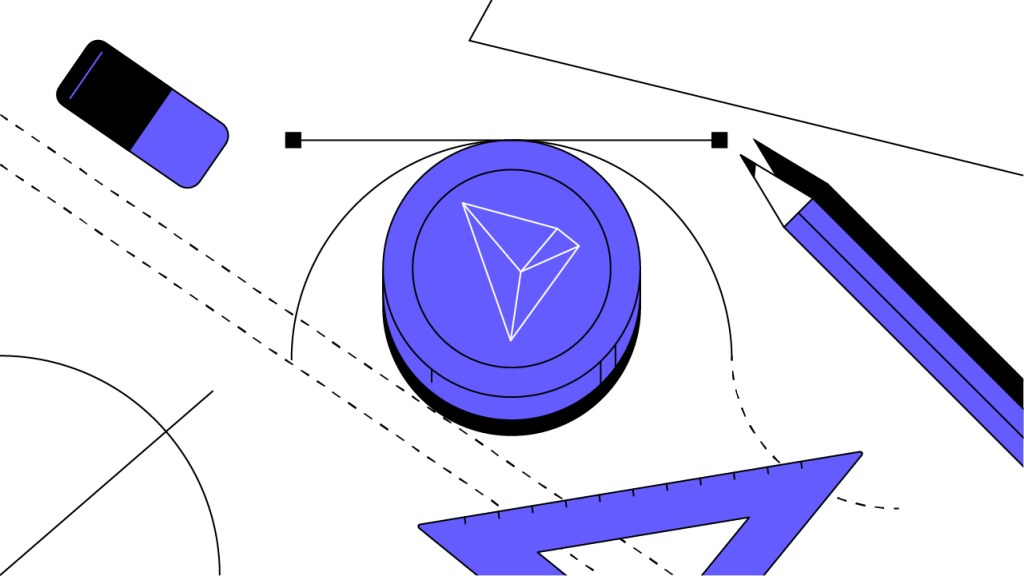Contents
Exploring the Technical Architecture of TRON
Read how TRON’s complex and sophisticated three-layer blockchain functions as a decentralized platform for both content creators and content consumers.
By Justin Sun , Founder, TRON
Updated March 8, 2021 • 4 min read

Summary
TRON is an online platform built for the widespread distribution of media and entertainment, and the platform’s native cryptocurrency is known as TRONix (TRX). This decentralized system leverages the strengths of blockchain to empower creators with access to low-cost distribution. The TRON blockchain platform is designed to foster the development of decentralized applications (dApps) and generally requires fewer computational resources for application development than other dApp-focused blockchains. The TRON blockchain network has already realized significant success, drawing comparisons with Ethereum and achieving a market capitalization of 2.1B USD (as of January 2021). The platform was launched in September 2017 by the TRON Foundation, a non-profit entity led by CEO Justin Sun, and is based in both Singapore and California.
Basics of TRON Blockchain Technical Architecture
The TRON blockchain protocol was modeled using the Google Protobuf (Protocol Buffers) system — a method for serializing structured data, designed to help platforms and systems communicate with each other quickly and efficiently. Like the Google Protobuf characteristics it employs, the TRON blockchain was built to streamline communications and ensure easy integration with a multitude of sophisticated programming languages. TRON is structured as a three-layered system consisting of a core layer, storage layer, and application layer, each of which are optimized for a specific set of functionalities.
The core layer performs multiple fundamental tasks that make up the foundation of the blockchain’s underlying protocol. One of the primary tasks is to drive TRON’s innovative consensus procedure for adding new blocks to the chain. This system is inspired by state-of-the-art Delegated Proof of Stake (DPoS) consensus architecture. This layer also oversees the management of accounts and the smart contracts that power the system. The programming language Solidity (created by the Ethereum network) was chosen as the foundational smart contract language for the TRON blockchain ecosystem. Solidity was specifically selected because of its compatibility with Ethereum and its aptitude for creating and maintaining decentralized applications (dApps) simply and efficiently.
The TRON storage layer is optimized to allow for more complex data storage needs within TRON’s evolving blockchain architectural landscape. It is designed to be utilized as a powerful distributed data storage system providing a high level of stability and security.
The application layer is designed to help software engineers effectively interact with the TRON ecosystem. Because the TRON blockchain features its own built-in smart contract system, it holds strong potential for supporting new applications built on top of the platform. Even now, the TRON blockchain supports a large number of wallets and dApps. One of the most prominent is decentralized crypto exchange JustSwap, the third most popular dApp in the TRON ecosystem. Another notable venture is called Sun, which is a DeFi initiative that allows users to stake the Tron cryptocurrency, or TRX, for mining and earn TRC-20 tokens in return.
Through its use of Google Protobuf standards, TRON encourages simple and universal integration with most programming languages and design methodologies. Furthermore, the Protobuf system improves the overall efficiency of the protocol and its developmental capabilities for constructing new applications.
TRON Virtual Machine (TVM)
The TRON Virtual Machine (TVM) was originally forked from the Ethereum Virtual Machine (EVM). TVM was specifically created to minimize resource use and ensure a robust system. This optimized virtual framework allows developers to easily access the TRON blockchain network at a low cost with its built-in energy mechanism — which accounts for transactions that do not charge TRX when executing operations. This systematic mechanism ensures several benefits: it helps prevent attacks on the platform, reduces the costs of application development, and lowers the resource costs of the platform itself.
The TVM is designed to be user-friendly and provide a convenient interface as a single point of focus for smart contract development and execution. On the Ethereum blockchain, each transaction costs a gas fee, and there is a maximum quota of gas that can be spent per block. If a new block on the chain exceeds this maximum threshold, it’s rejected. But, if an attacker somehow includes excess transactions into a newly forming block, they can effectively prevent a block from being added. In contrast, with TRON’s TVM, every transaction expends energy and bandwidth points. Instead of a globalized or cumulative threshold, each account is separately tabulated.
As a result, every account must purchase energy, and is alloted 5,000 bandwidth points per day. If an account exhausts these points, they must freeze their tokens for at least three days to generate more. It’s also possible for an account to hold insufficient bandwidth points or energy. When this happens, the system will consume the Tron coin in their account to make up for the discrepancy. By shifting transaction costs from a cumulative global model to an account-specific system, the TRON blockchain (unlike Ethereum) reduces the likelihood of attack via Denial-of-Service (DoS) methods.
TRON 4.0 and zk-SNARKs Introduction
TRON 4.0 was launched in July of 2020. This newest update to the TRON blockchain protocol introduces the TRONZ privacy protocol, powered by zk-SNARK technology. zk-SNARKs is a cryptographic proof system that makes use of what are called shielded transactions to provide decentralized transaction confirmation without sharing any private or confidential data. TRON 4.0 also features TRC-20 tokens based on the TRON blockchain (similar to ERC-20 tokens on Ethereum), as well as TRONZ, a system powering three different types of shielded transactions at very low transaction fee rates. Comparatively, the Ethereum platform tends to charge between four and 600 times as much as TRON for executing shielded transactions.
TRON gives its users three options for conducting shielded transactions with TRC-20 tokens. The first option allows participants to use a standard TRC-20 token and convert it to shielded form, which is called a “mint” transaction on the network. Second, users can leverage the shielded version of a token to transform it into standard form via the “burn” option. Lastly, users can move money between accounts via the “transfer” function. This option hides the identities of the buyer and seller, as well as the amount being transferred.
Transactions on the TRON blockchain network have many advantages. Third parties can verify transactions of any size, and transaction data is saved on the blockchain using advanced encryption techniques. TRON’s extensive shielded transaction features are a powerful set of tools, but on top of this, TRON is also focused on maintaining a globally adoptable blockchain paradigm. Therefore, the TRX token will not allow for anonymous or shielded transactions. A significant milestone for TRON 4.0 is the introduction of a new two-layer consensus mechanism that increases the power of the TRON blockchain exponentially. Specifically, it reduces block confirmation times from an average of 57 seconds down to just three seconds — making the TRON blockchain one of the fastest of the top 25 major cryptocurrency networks.
TRON continues to gain the confidence of investors and developers in the blockchain industry as it expands its usability and user-base. One of TRON’s latest accomplishments is its acquisition of DLive, a TRON-based streaming platform designed by the renowned BitTorrent organization.
Cryptopedia does not guarantee the reliability of the Site content and shall not be held liable for any errors, omissions, or inaccuracies. The opinions and views expressed in any Cryptopedia article are solely those of the author(s) and do not reflect the opinions of Gemini or its management. The information provided on the Site is for informational purposes only, and it does not constitute an endorsement of any of the products and services discussed or investment, financial, or trading advice. A qualified professional should be consulted prior to making financial decisions. Please visit our Cryptopedia Site Policy to learn more.

Author
Justin Sun
Founder, TRON
Justin Sun is the founder of TRON, one of the world's largest decentralized blockchain ecosystems, and CEO of BitTorrent, the leader in peer-to-peer software and services. A protege of Alibaba's Jack Ma, in 2017 Sun was named to Forbes' 30 under 30 list for China and 30 under 30 Asia in the Consumer Technology category. Sun is an avid gamer, investor, and philanthropist.
Is this article helpful?


